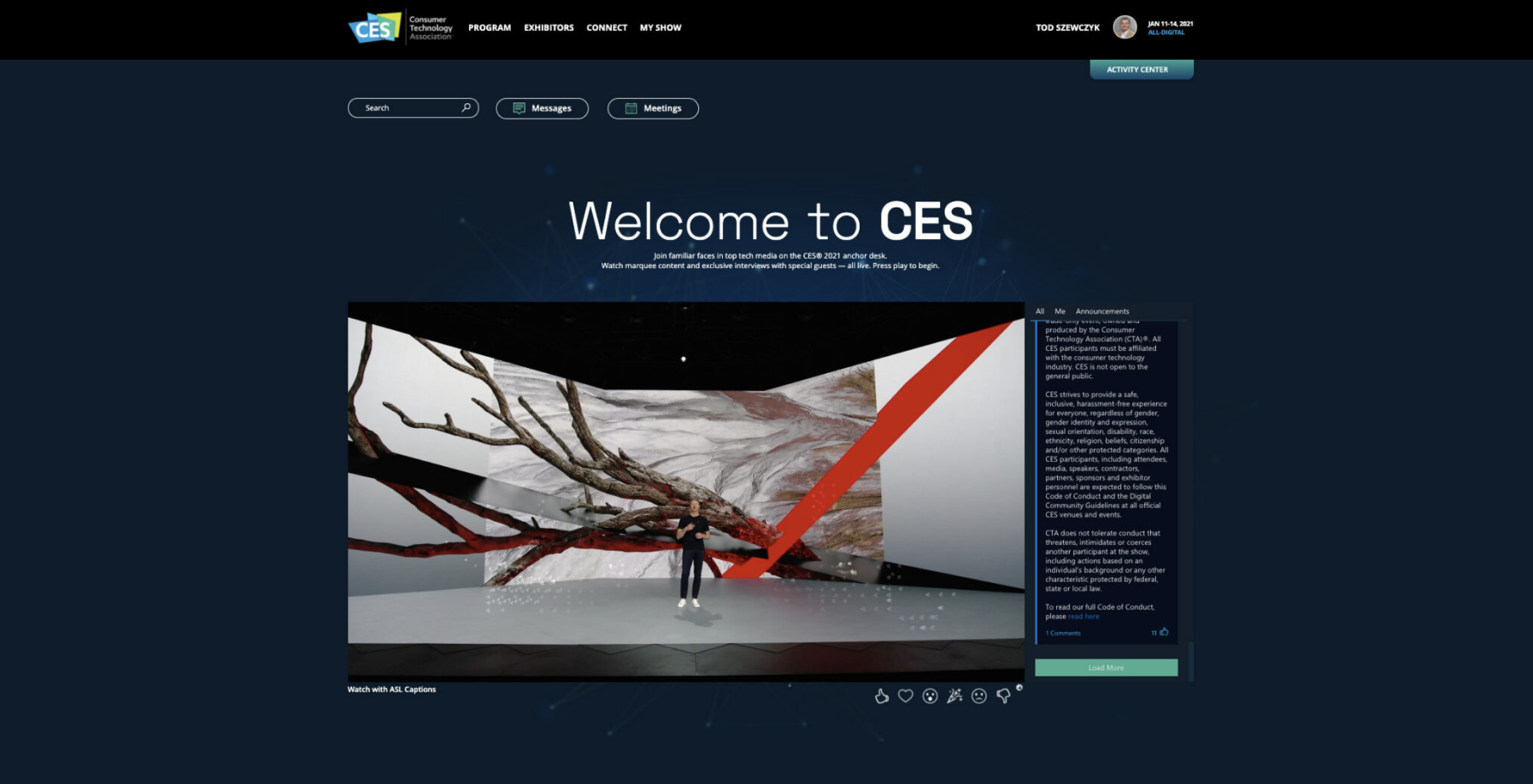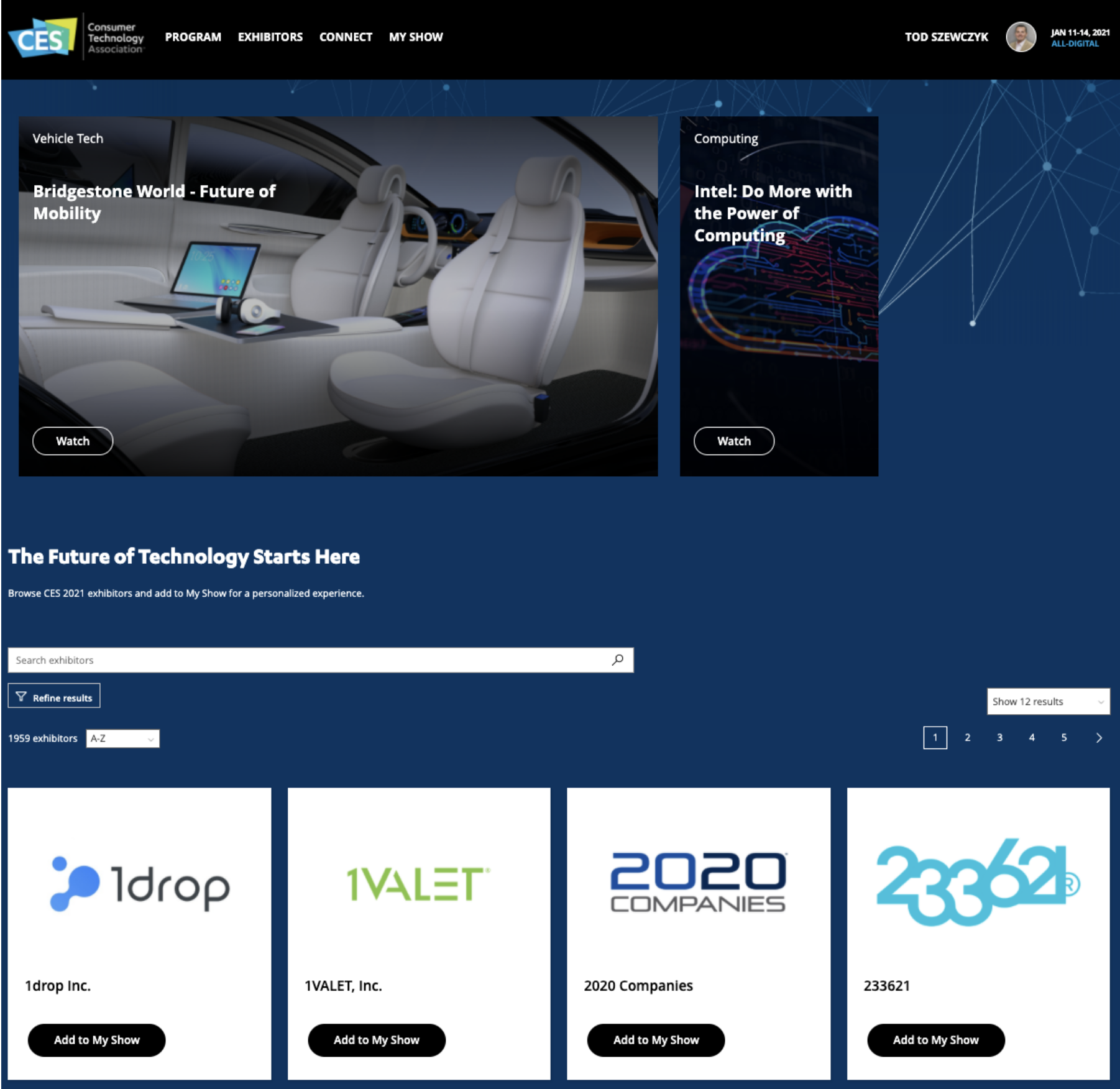TOP FIVE TAKEAWAYS FROM THE 2021 CES DIGITAL VENUE
I wrote this post in the middle of AJ’s Virtual Platform content series. While most reviews of CES are focused on the new gadgets, technologies and announcements, I wanted to focus on the digital experience the event put on as it was fully virtual.
My top five takeaways from the 2021 CES Digital Venue are:
Create a simple to use Digital Venue interface that doesn’t overwhelm with complications
Take a cue from Verizon, brands should provide immersive, multi-device keynote show experiences with interactive content to captivate their audience
Digital Venues should allow for user discovery but also provide hints and prompts to help the journey.
Exhibitors should provide immersive companion micro-sites to let visitors go deep on their products and story.
As a rule, any digital venue should provide a recommendation engine to fuel discovery of exhibitors based on registration data.
As someone who has attended the Consumer Electronics Show (CES) for the past 7 years, I was a bit disappointed by not being in Las Vegas last week. There is simply no other live event that provides the depth and breadth of what’s next in technology, trends and networking on the planet. I was definitely skeptical that the virtual version of CES could measure up to the live experience. From a platform standpoint, I’d have to say kudos to Bob Bejan, CVP Global Events at Microsoft, and team for putting together what looks to be a leading-edge virtual event platform and experience.
This post will not be through the lens of the new technology, gadgets or trends coming out of CES, but will focus on what the virtual event experience was like. Picking up a quote from Bejan in the announcement that Microsoft would be CES’s event technology partner, he said, “…you cannot translate a live event into a digital format. You must remake the event entirely.” I’d have to say I totally agree.
The CES Digital Venue reportedly used ‘Microsoft Cloud solutions, including Microsoft Azure, Microsoft Teams and the Microsoft Power Platform, together with partner solutions’ to provide the overall experience.
As a starting point, let’s take a look at Hans Vestberg’s keynote on 5G, he’s Verizon’s Chairman and CEO. Vestberg and his team definitely leaned into the idea of remaking the keynote virtually. Set on what appeared to be an XR Studio stage, the keynote blended traditional stand-and-deliver content with remote picture-in-picture interviews, on-stage co-hosting with AR flourishes and a full, second-screen mobile experience.
While the show was interspersed with pre-recorded content, the live content was surrounded by a background of crisp 3D imagery and animations that captivated and held my attention throughout. Vestberg was fully visible from head to foot as was his momentary co-host, football & baseball star Deon Sanders. There was a nice moment where AR football players moved fluidly between them.
Additionally, just before Vestberg interviewed Lonnie G. Bunch III, Secretary of the Smithsonian, an AR render of the Apollo 11 Command Module floated next to him on stage. This interplay of augmented content with live host in a virtual setting is starting to become a storytelling trend in virtual events and shows the flexibility and creativity of what can be done in XR.
All of this was beamed through the Microsoft platform seamlessly with very little lag time. The video frame allowed me to push the stream to full-frame and, although I could pause the feed, I was brought to live when I un-paused instead of picking back up where I left off.
The event platform itself offered the standard gamification elements from live chat functionality along the right sidebar to emoji buttons along the bottom of the frame. The emoji’s continually flashed throughout the keynote and were somewhat distracting to my eye. Moving down the event page, there were multiple content carousels with recommendations on other keynotes to attend that were relative to the topic I was viewing.
While I had added the Verizon session to my agenda before it went live, I did not receive an email prompt that session I had registered in was starting, this felt like a missed opportunity from an engagement standpoint. One piece of the show that I missed in the beginning was the audience center host experience, that said, providing a virtual home base in the venue for users to start and return is a best practice to create a sense of place.
A quick word on the Black Pumas second screen experience. After the Verizon keynote was over, the Black Pumas played a few songs. While this was fully visible on my laptop, I could also scan a QR Code with my phone to go on stage and watch from that close up view. After I scanned the code, I waited for a few minutes for the content to load. Once it did, I could control the camera angle and watch up close as if I was on stage. There was a bit of a lag between the stream on my phone and laptop, my phone was not on 5G and my laptop was picking up the signal through wifi. Lag notwithstanding, I found the content to be engaging and stuck around until the end.
All told, I remain impressed with the Digital Venue’s functionality and appreciated all of the effort the Verizon team put forward in producing a highly immersive and engaging keynote.
Another notable session at the event was iHeartMedia’s Reimagining Entertainment presentation with Ryan Seacrest and Dua Lipa, along with a performance by Billie Eilish that was hosted in Spatial Web’s platform. CNET covered what the Spatial Web experience was like, attendees were able to teleport to virtual rooms, surrounded by spatial audio and also had the ability to walk up and start a conversation with other groups of people. These types of serendipity platforms are nascent and will continue to grow throughout the year as a way to recreate the live concert experience.
Moving over to one the key aspects of CES, the Exhibitors, or ‘Show Floor”, I found the entire experience to be underwhelming. In previous years attending CES, I’ve spent weeks planning out what booths to visit and setting meeting times. With the move to virtual, I was hoping/expecting that Microsoft would employ some type of recommendation engine based on the data I provided at registration. This did not appear to be the case. Whenever I went to the Exhibitor area, I was offered a blank search box with a number of tiles below to companies that had no relation to the information I entered at registration. Perhaps this was some type of sponsorship strategy? While I understand the need to monetize, there simply has to be a better way to give users a personalized experience and a way to discover new companies.
Moving on to the company booth experience, clearly, there is no way to re-create the physical booth experience in a virtual setting. I was able to make connections with a couple of companies and used the live chat function in a few of the booths. Intel’s booth has always been a highlight of the show, their display of the latest tech and the experiences it can create is beyond compare. This year, their virtual booth offers a ton of content from presentations to sessions to a way to connect. All well laid out and visually appealing.
There is also a companion micro-site that pushes you out of the CES experience found within their booth. This is where things got interesting and made me feel like I was at CES. On the microsite, they offer a chance to visit “The City of Doers” which is an immersive experience that walks you through how their technology is evolving the way we ‘work, play and move through the world’. This experience allows me to click into different areas of a city block and see Intel’s technology in action. Presumably built in WebGl, the interface is smooth and provides an in-depth experience that the CES site itself does not. More and more, these types of immersive micro-sites will be the part of a virtual event that captures visitor’s attention and provides them with that surprise and delight experience that live offers.
In general, I thought Microsoft’s virtual platform worked really well, and the fact that I have another 30 days to go through all of the content is definitely a big bonus. Although it wasn’t the full Vegas experience, and there are clearly areas that need to improve, this is a good glimpse of what virtual/hybrid events will become this year. The immersive micro-site linked to the company booth is a trend that will only grow, and it will be interesting to see if any event platform starts to offer this functionality. Going back to Bob Bejan’s quote, there is no way to recreate what a live event is digitally, but there is a way to make the virtual event experience compelling. I think this year’s CES showed what that looks like and also how powerful virtual events can be.











